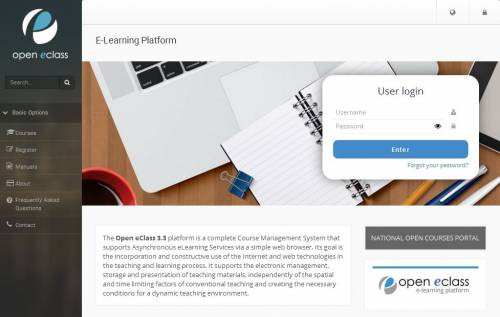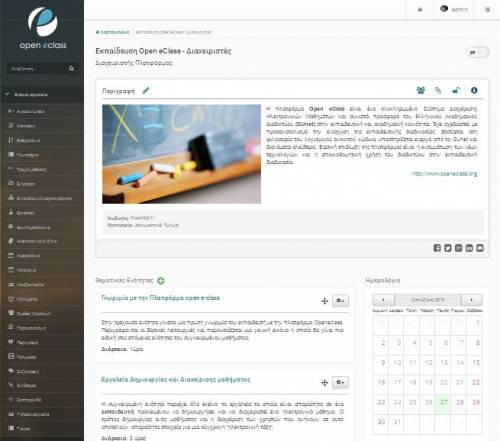Short Description
The Open eClass platform is an integrated e-Course Management System and is the proposal of the Academic Internet (GUnet) for the support of Asynchronous Distance Learning Services. It has been designed with an orientation to enhance the educational process, is based on the philosophy of open source software, is actively supported by GUnet and is freely distributed. The introduction of Asynchronous Telemedicine opens up new possibilities in education, offering a means of interaction and continuous communication between the trainer and the trainee. At the same time, the electronic organization, storage and presentation of educational material is supported, independent of the limiting factors of space and time of traditional teaching, creating the conditions for a dynamic educational environment. The Open eClass platform is designed to implement new educational activities.
Features and functionalities
Compatibility with all browsers: Open eClass is accessed using a simple web browser. The Open eClass platform is fully functional in all browsers.
Customizable user interface: The Open eClass platform features a modern and responsive user interface, based on Bootstrap 3x, to adapt to the screens of different devices, including computers, tablets and smartphones. Users can also access Open eClass directly on their tablet or mobile device and through mobile apps for iOS and Android mobile devices.
Compatibility with e-learning standards: the Open eClass platform is compatible with international standards (SCORM, IMSCP) which ensure the reusability, accessibility and resilience of the educational material to technological changes, as well as interoperability between e-learning systems.
Creation & Management of Online Courses. Specifically, the platform supports:
- distinct ways of accessing courses: open courses, courses requiring registration, closed courses, inactive courses
- discrete course formats: simple format, weekly format, module-based course
- backups: ensuring the entire course content in case of accidental deletion or destruction of the course.
- distinct user roles: teacher, student, administrator (additional roles: teacher assistant, Group Turor, guest),Reviewer.
Management of educational content
- Documents: Organising, storing and presenting course content.
- Multimedia: storage and distribution of audiovisual material.
- Blog: Publishing text posts in chronological order.
- Glossary: Adding and managing key terms .
- E-book: Posting, managing and presenting e-books in HTML format.
- Wall: Reading of multi-content posts (video, documents, multimedia).
- Links: Adding and organizing useful resources from the Internet .
- Learning Path: Organization of educational material into structured modules. Export to SCORM package.
- H5P content: a tool for creating interactive course objects
- Mindmap: Conceptual analysis of course concepts.
Information, communication & cooperation tools
- Announcements: Posting of course announcements.
- Calendar: Chronological presentation of events-stages of the course.
- Messages: Exchange of messages between instructors and trainees.
- Announcments: Notification of anything new regarding the course.
- Forum: Asynchronous exchange of views and ideas.
- Teleconference: the ability to communicate and collaborate in real time.
- Groups: Grouping users to have a common discussion area and file upload area.
- Wiki: Collaborative authoring.
- Chat: Real-time communication by text message, between instructors and learners.
Evaluation & feedback tools
- Exercises: Production of closed-ended exercises (multiple choice, matching, fill-in-the-blank).
- Assignments: Management, submission and marking of assignments.
- Questionnaires: Creating polls and surveys.
- Gradebook: Recording trainee scores.
- Attendance: Recording trainee attendance/absence.
- Progress: helps learners to improve their performance and achieve their goals
- Statistics: User statistics.
E-learning management tools
- Settings: the basic course settings tool (title, description, metadata, format, access, licenses, etc.).
- Users: List of registered users, roles, registration and de-registration of users (individual, group or with rules).
- Tools: enable, disable, add external tools (links, tools, LTI, etc.).
- Learning analytics: Analytical reports on monitoring and achievement of learning objectives.
Contact
For more information please visit platform’s web portal in: http://www.openeclass.org

